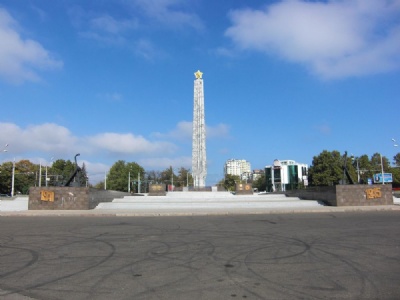Odessa
The port city of Odessa is located in southern Ukraine and was at the time of the outbreak of the Second World War part of Soviet Union. When Germany invaded Soviet Union June 22, 1941, Romanian troops participated in the attack. Odessa was located in a district called Transnistria and was within the Romanian occupation plans. At the end of July 1941, Hitler made a request to the Romanian dictator Antonescu for a final attack on Odessa. On August 8, Romanian troops launched the attack on Odessa, which by then encircled from three directions. But the Soviet troops in the city defended themselves furiously and prevented the Romanian attackers from capturing the city. From the sea, reinforcements and materials arrived for the hard-pressed Soviet troops, which helped them to fight on.
In mid-September, the Soviet troops began to retreat southeast towards Odessa. This after a decision by Moscow to abandon Odessa and evacuate the remaining troops by sea to the Crimean peninsula. During the first two weeks of October, about 120,000 soldiers and civilians were evacuated by the Soviet Black sea fleet. Add to that a large number of tonnage in materiel vital for future fighting. At the same time as the evacuation was carried out, there were fierce delay fighting inside Odessa. When the evacuation was completed October 15, the remaining enclosed troops surrendered and faced a very uncertain fate in german captivity.
The Romanian losses amounted about 18,000 dead while the soviets amounted about 16,500. The region in which Odessa is located was incorporated into Romania. Odessa was occupied until April 1944 when it was recaptured by Soviet troops. Throughout the occupation, Soviet partisans ravaged in and around Odessa and were a constant threat to the Romanian occupiers. In the wake of the occupation, a wave of massacres followed on Odessa’s Jews.
Current status: Museums/monuments (2009).
Location: 46° 26' 22.71" N 30° 45' 24.41" E
Get there: Tram or bus.
Follow up in books: Bellamy, Chris: Absolute War: Soviet Russia in the Second World War (2008).


Odessa is one of twelve cities in the former Soviet Union awarded the title Hero City for its sacrificial and heroic defense against the fascist attackers. The award was given in 1965 and consists of an obelisk in central Odessa. In addition to this monument, there are several smaller monuments and museums dedicated to the siege between August and October 1941. Not at all as lavish as the counterparts in Moscow, Stalingrad, Kiev, Leningrad and Minsk. Unfortunately, I did not have the opportunity to visit them all when I was in Odessa.
Odessa is perhaps best known for the Potemkin Stairs down by the harbor. It was here that one of the most famous scenes in film history was filmed in Sergei Eisenstein’s film Battleship Potemkin (1925). Panic breaks out among people on the stairs when armed tsarist forces open fire. The scene itself is long and drawn out and the most memorable sequence is the one with the stroller rolling down the stairs through the crossfire.